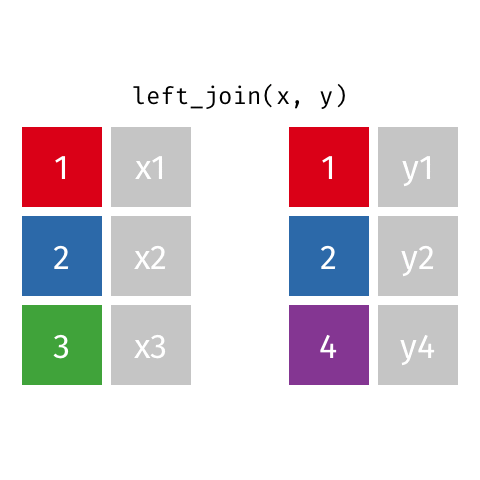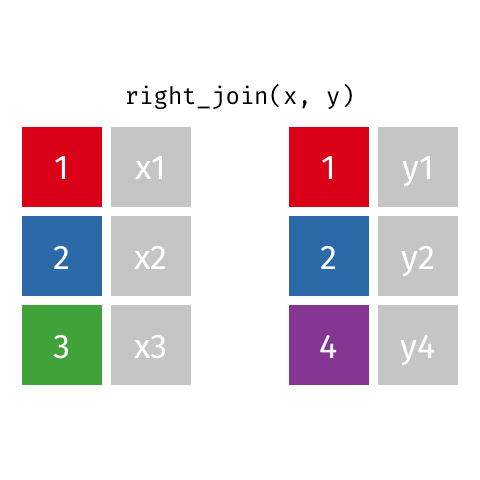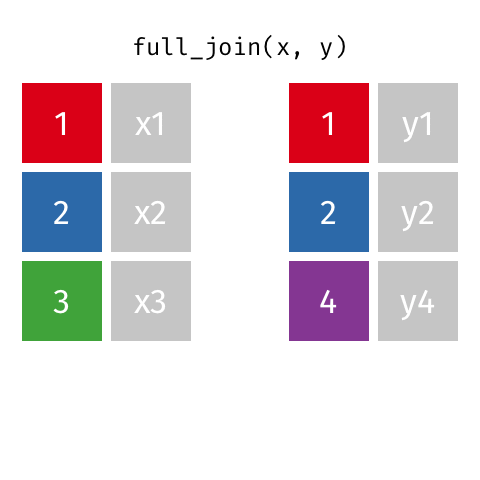- Learners can apply functions from the dplyr R Package to join multiple data sets.
- Learners can add literature references to Quarto files using the navigation menu of RStudio visual editor and using an exported collection in .bib format from Zotero Reference Management software
- Learners can use the GitHub pages service to publish a repository as a standalone website.
Joining tables & Creating and publishing scholarly articles with Quarto and GitHub pages
Research Beyond the Lab: Open Science and Research Methods for a Global Engineer
2024-04-11
Learning Objectives (for this week)
Part 1: Homework module 6
Metadata: data about data
WHAT!?
Faecal sludge samples
Imagine:
- you are new to WASH research and you have never heard of feacal sludge management.
- you are interested in learning more about the topic and you want to find some data to play with.
- you find a publication with a dataset on faecal sludge characteristics.
Faecal sludge samples
You download the XLSX file that contains the data and you open it in Excel. You see the following:
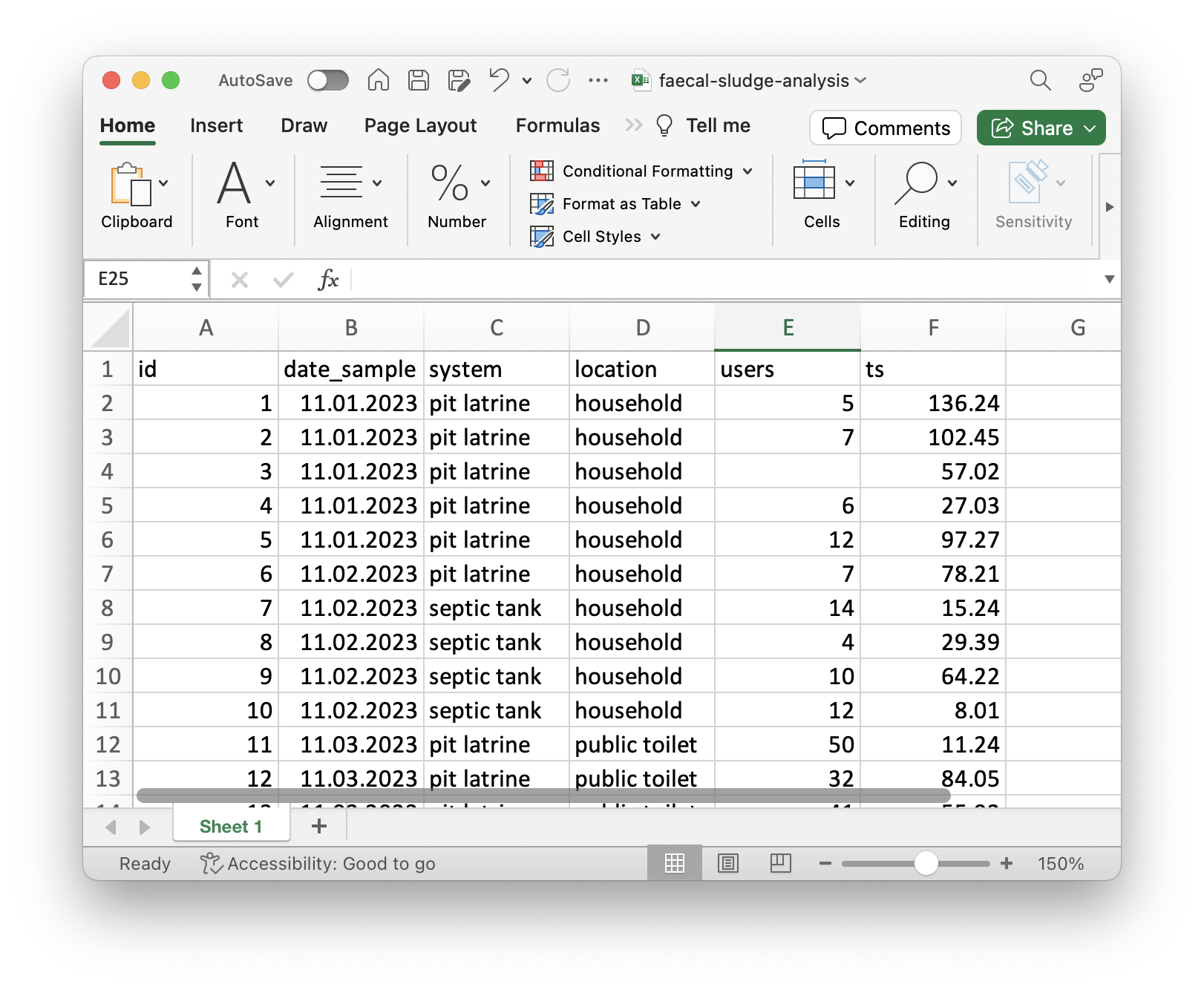
Faecal sludge samples
Open questions:
- What unit does
usersrefer to? - What does
tsstand for? - The
dateof what? - Where was this data collected?
- Which method was used to collect the samples?

Questions that only the original author may have the answers to.
You as an author
have the chance to document your data properly once to make it easier for everyone else to know what it contains.
Documentation
Goes into a separate README file
- General information (authors, title, date, geographic location, etc.)
- Sharing / access information (license, links to publications, citation)
- Methodological information (sampling, analysis, etc.)
Data dictionary
Goes into a separate file (dictionary.csv).
Minimum required information
- Variable name
- Variable description
Data dictionary for faecal sludge samples
- Edit in spreadsheet software (e.g. MS Excel)
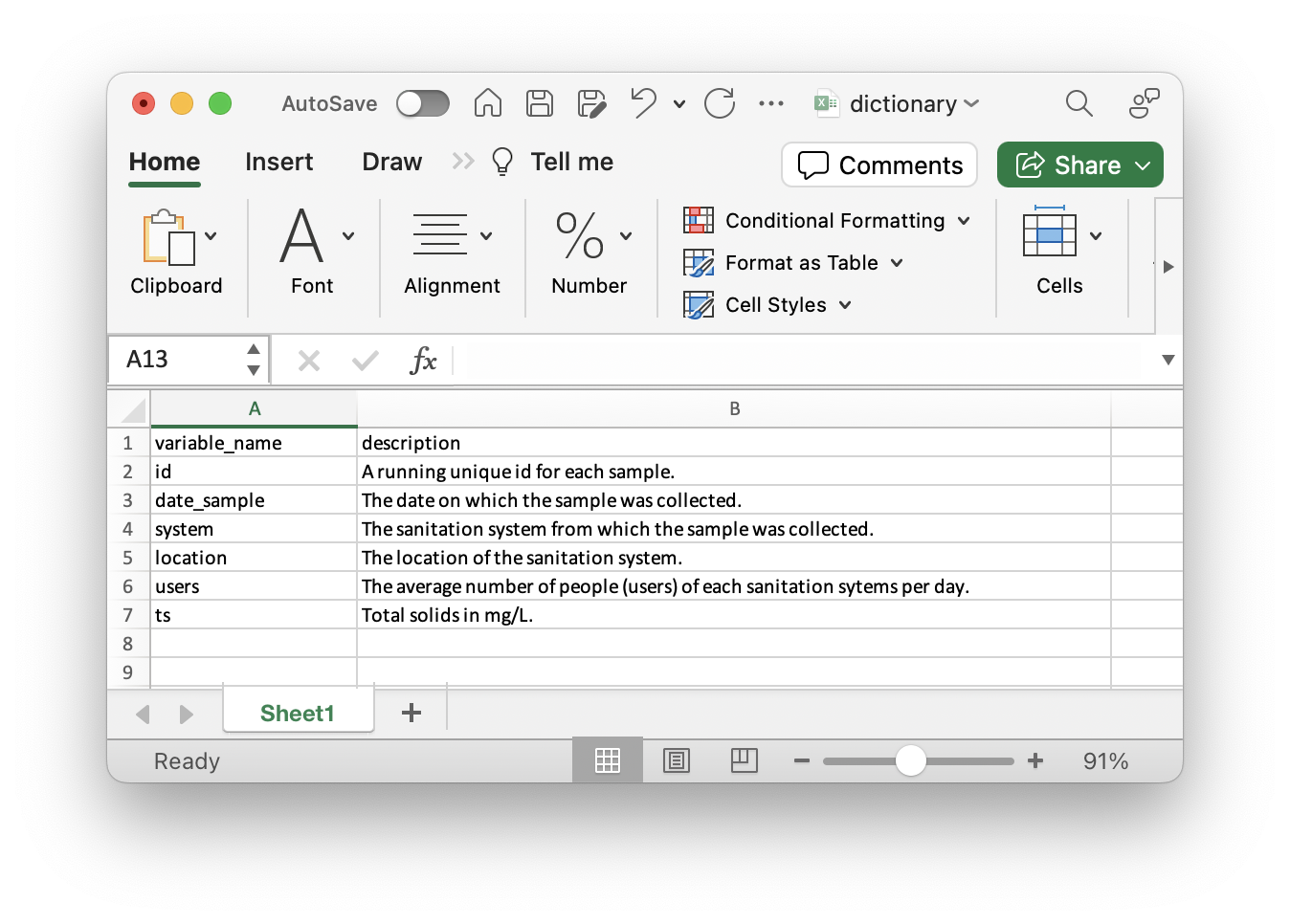
Data dictionary for faecal sludge samples
- Save as CSV file
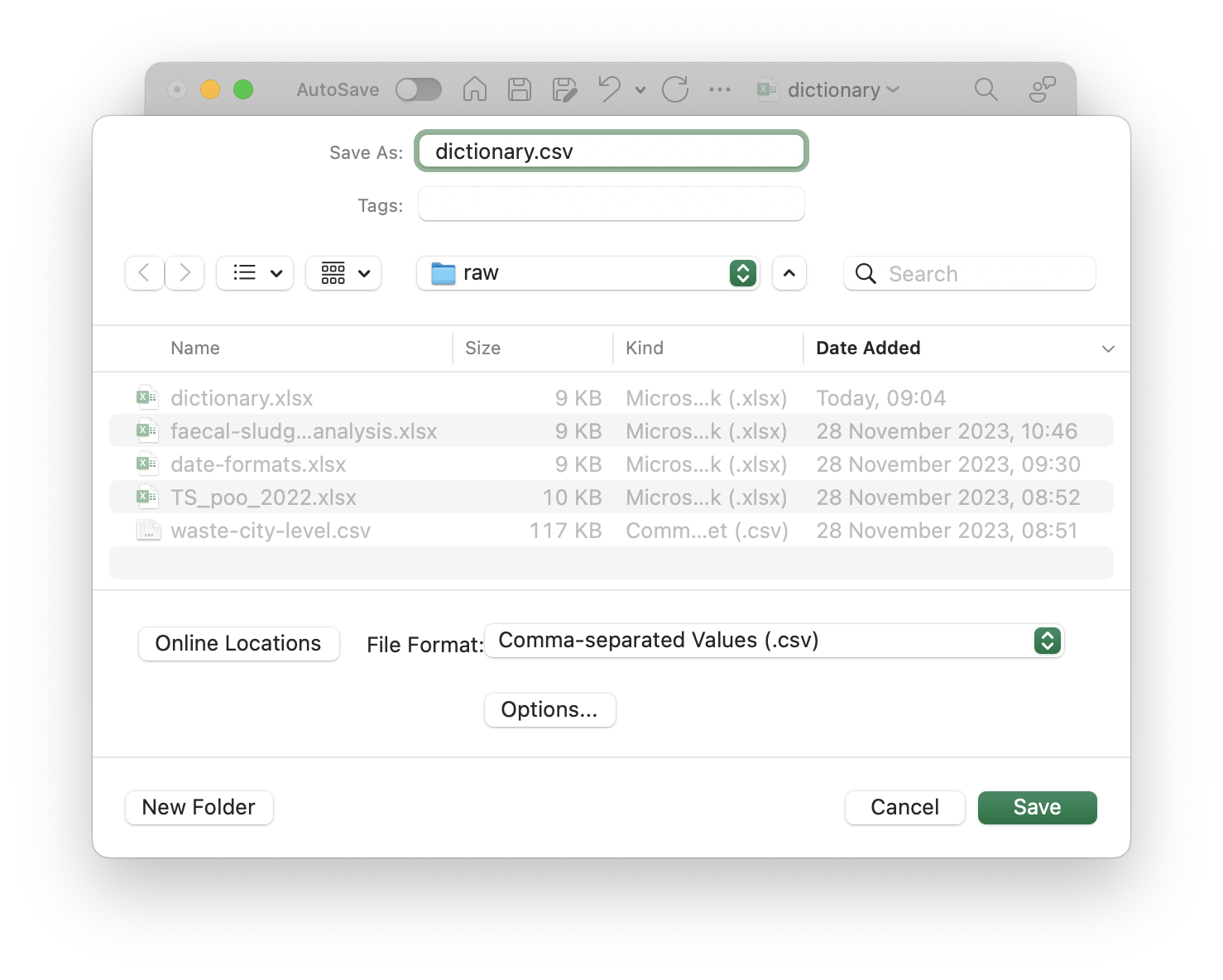
Directory tree of a project
Capstone project of Rainbow Train: https://github.com/rbtl-fs24/project-rainbow-train
.
├── R
│ └── 01-data-preparation.R
├── data
│ ├── processed
│ │ ├── README.md
│ │ ├── dictionary.csv
│ │ └── faecal-sludge-analysis.csv
│ └── raw
│ └── Faecal sludge Analysis_05112023.xlsx
├── docs
│ ├── index.html
│ ├── index.qmd
│ └── index_files
│ └── libs
└── project.RprojDirectory tree of a project
Rfolder: R scripts for data cleaningdatafolder: raw and processed datadocsfolder: the actual report that imports the processed dataproject.Rproj: RStudio project file
Inside the data folder
raw: data as it was downloaded / as you received it (e.g. Excel file)processed: data that is ready to be used in the report
Inside the processed folder
README.md: general information about the datadictionary.csv: data dictionaryfaecal-sludge-analysis.csv: cleaned data for whichdictionary.csvapplies
Part 2: Joining data
We…
…have multiple data frames
…want to bring them together
Data: Women in science
Information on 10 women in science who changed the world
| name |
|---|
| Ada Lovelace |
| Marie Curie |
| Janaki Ammal |
| Chien-Shiung Wu |
| Katherine Johnson |
| Rosalind Franklin |
| Vera Rubin |
| Gladys West |
| Flossie Wong-Staal |
| Jennifer Doudna |
Inputs
| name | profession |
|---|---|
| Ada Lovelace | Mathematician |
| Marie Curie | Physicist and Chemist |
| Janaki Ammal | Botanist |
| Chien-Shiung Wu | Physicist |
| Katherine Johnson | Mathematician |
| Rosalind Franklin | Chemist |
| Vera Rubin | Astronomer |
| Gladys West | Mathematician |
| Flossie Wong-Staal | Virologist and Molecular Biologist |
| Jennifer Doudna | Biochemist |
| name | birth_year | death_year |
|---|---|---|
| Janaki Ammal | 1897 | 1984 |
| Chien-Shiung Wu | 1912 | 1997 |
| Katherine Johnson | 1918 | 2020 |
| Rosalind Franklin | 1920 | 1958 |
| Vera Rubin | 1928 | 2016 |
| Gladys West | 1930 | NA |
| Flossie Wong-Staal | 1947 | NA |
| Jennifer Doudna | 1964 | NA |
| name | known_for |
|---|---|
| Ada Lovelace | first computer algorithm |
| Marie Curie | theory of radioactivity, discovery of elements polonium and radium, first woman to win a Nobel Prize |
| Janaki Ammal | hybrid species, biodiversity protection |
| Chien-Shiung Wu | confim and refine theory of radioactive beta decy, Wu experiment overturning theory of parity |
| Katherine Johnson | calculations of orbital mechanics critical to sending the first Americans into space |
| Vera Rubin | existence of dark matter |
| Gladys West | mathematical modeling of the shape of the Earth which served as the foundation of GPS technology |
| Flossie Wong-Staal | first scientist to clone HIV and create a map of its genes which led to a test for the virus |
| Jennifer Doudna | one of the primary developers of CRISPR, a ground-breaking technology for editing genomes |
Desired output
| name | profession | birth_year | death_year | known_for |
|---|---|---|---|---|
| Ada Lovelace | Mathematician | NA | NA | first computer algorithm |
| Marie Curie | Physicist and Chemist | NA | NA | theory of radioactivity, discovery of elements polonium and radium, first woman to win a Nobel Prize |
| Janaki Ammal | Botanist | 1897 | 1984 | hybrid species, biodiversity protection |
| Chien-Shiung Wu | Physicist | 1912 | 1997 | confim and refine theory of radioactive beta decy, Wu experiment overturning theory of parity |
| Katherine Johnson | Mathematician | 1918 | 2020 | calculations of orbital mechanics critical to sending the first Americans into space |
| Rosalind Franklin | Chemist | 1920 | 1958 | NA |
| Vera Rubin | Astronomer | 1928 | 2016 | existence of dark matter |
| Gladys West | Mathematician | 1930 | NA | mathematical modeling of the shape of the Earth which served as the foundation of GPS technology |
| Flossie Wong-Staal | Virologist and Molecular Biologist | 1947 | NA | first scientist to clone HIV and create a map of its genes which led to a test for the virus |
| Jennifer Doudna | Biochemist | 1964 | NA | one of the primary developers of CRISPR, a ground-breaking technology for editing genomes |
Inputs, reminder
Joining data frames
left_join(): all rows from xright_join(): all rows from yfull_join(): all rows from both x and y- …
Setup
For the next few slides…
left_join()
left_join()
| name | profession | birth_year | death_year |
|---|---|---|---|
| Ada Lovelace | Mathematician | NA | NA |
| Marie Curie | Physicist and Chemist | NA | NA |
| Janaki Ammal | Botanist | 1897 | 1984 |
| Chien-Shiung Wu | Physicist | 1912 | 1997 |
| Katherine Johnson | Mathematician | 1918 | 2020 |
| Rosalind Franklin | Chemist | 1920 | 1958 |
| Vera Rubin | Astronomer | 1928 | 2016 |
| Gladys West | Mathematician | 1930 | NA |
| Flossie Wong-Staal | Virologist and Molecular Biologist | 1947 | NA |
| Jennifer Doudna | Biochemist | 1964 | NA |
right_join()
right_join()
| name | profession | birth_year | death_year |
|---|---|---|---|
| Janaki Ammal | Botanist | 1897 | 1984 |
| Chien-Shiung Wu | Physicist | 1912 | 1997 |
| Katherine Johnson | Mathematician | 1918 | 2020 |
| Rosalind Franklin | Chemist | 1920 | 1958 |
| Vera Rubin | Astronomer | 1928 | 2016 |
| Gladys West | Mathematician | 1930 | NA |
| Flossie Wong-Staal | Virologist and Molecular Biologist | 1947 | NA |
| Jennifer Doudna | Biochemist | 1964 | NA |
full_join()
full_join()
| name | birth_year | death_year | known_for |
|---|---|---|---|
| Janaki Ammal | 1897 | 1984 | hybrid species, biodiversity protection |
| Chien-Shiung Wu | 1912 | 1997 | confim and refine theory of radioactive beta decy, Wu experiment overturning theory of parity |
| Katherine Johnson | 1918 | 2020 | calculations of orbital mechanics critical to sending the first Americans into space |
| Rosalind Franklin | 1920 | 1958 | NA |
| Vera Rubin | 1928 | 2016 | existence of dark matter |
| Gladys West | 1930 | NA | mathematical modeling of the shape of the Earth which served as the foundation of GPS technology |
| Flossie Wong-Staal | 1947 | NA | first scientist to clone HIV and create a map of its genes which led to a test for the virus |
| Jennifer Doudna | 1964 | NA | one of the primary developers of CRISPR, a ground-breaking technology for editing genomes |
| Ada Lovelace | NA | NA | first computer algorithm |
| Marie Curie | NA | NA | theory of radioactivity, discovery of elements polonium and radium, first woman to win a Nobel Prize |
Putting it altogether
| name | profession | birth_year | death_year | known_for |
|---|---|---|---|---|
| Ada Lovelace | Mathematician | NA | NA | first computer algorithm |
| Marie Curie | Physicist and Chemist | NA | NA | theory of radioactivity, discovery of elements polonium and radium, first woman to win a Nobel Prize |
| Janaki Ammal | Botanist | 1897 | 1984 | hybrid species, biodiversity protection |
| Chien-Shiung Wu | Physicist | 1912 | 1997 | confim and refine theory of radioactive beta decy, Wu experiment overturning theory of parity |
| Katherine Johnson | Mathematician | 1918 | 2020 | calculations of orbital mechanics critical to sending the first Americans into space |
| Rosalind Franklin | Chemist | 1920 | 1958 | NA |
| Vera Rubin | Astronomer | 1928 | 2016 | existence of dark matter |
| Gladys West | Mathematician | 1930 | NA | mathematical modeling of the shape of the Earth which served as the foundation of GPS technology |
| Flossie Wong-Staal | Virologist and Molecular Biologist | 1947 | NA | first scientist to clone HIV and create a map of its genes which led to a test for the virus |
| Jennifer Doudna | Biochemist | 1964 | NA | one of the primary developers of CRISPR, a ground-breaking technology for editing genomes |
Take a break
Please get up and move! Let your emails rest in peace.
10:00
Image generated with DALL-E 3 by OpenAI
Part 2: Reference Management
Four terms
- Citation
- Reference
- Bibliography
- Citation Style Language (CSL)
What’s a Citation?
- Inequality underpins waste management systems, structuring who can or cannot access services (Kalina et al., 2023).
- Many visitors still expect a personal pick-up, despite the availability of taxi services (Tilley & Kalina, 2021).
- In Tilley & Kalina (2021), the authors describe how visitors still expect a personal pick-up, despite the availability of taxi services.
What’s a Citation?
- Inequality underpins waste management systems, structuring who can or cannot access services (Kalina et al., 2023).
- Many visitors still expect a personal pick-up, despite the availability of taxi services (Tilley & Kalina, 2021).
- In Tilley & Kalina (2021), the authors describe how visitors still expect a personal pick-up, despite the availability of taxi services.
Important: The period is after the citation.
What’s a Reference?
- detailed description of the source of information
- author’s name, title, year of publication, publisher, DOI, etc.
Tilley, E., & Kalina, M. (2021). “My flight arrives at 5 am, can you pick me up?”: The gatekeeping burden of the african academic. Journal of African Cultural Studies, 33(4), 538–548. https://doi.org/10.3929/ethz-b-000493677
What’s a Bibliography?
- list of references in a research paper or project
- includes all sources used, whether they were directly quoted or not
- listed alphabetically by the author’s last name in the reference list
References
What’s the Citation Style Language (CSL)?
- It’s what your citation and generated bibliography look like
- APA (American Psychological Association) Style, Chicago Style, IEEE Style, Vancouver Style, etc. (over 10,000 styles in Zotero Style Repository)
What’s the Citation Style Language (CSL)?
author-date: Many visitors still expect a personal pick-up, despite the availability of taxi services (Tilley & Kalina, 2021).
numeric Many visitors still expect a personal pick-up, despite the availability of taxi services [1].
Why use a reference management tool?
Photo by Christian Erfurt on unsplash.com
Why use Zotero?
- free
- open source: developed in public
- transparent about access to your own data
- cross-platform (Windows, Mac, Linux)
- collaboration in groups
- integration with word processors
Photo by Sincerely Media on unsplash.com
Scholarly Articles in Quarto
Quarto supports
a standardized schema for authors and affiliations that can be expressed once int the source document,
the use of Citation Style Language (CSL) to automate the formatting of citations and bibliographies, and
outputting to
pdf,html, anddocxwith custom formatting,
according to the styles required for various journals,
and creating the LaTeX required for submission to multiple journals.
Front matter
Quarto provides a rich set of YAML metadata keys to describe the details required in the front matter of scholarly articles.
- title
- author
- affiliation
- abstract
- keywords
- citation
- licensing
- etc.
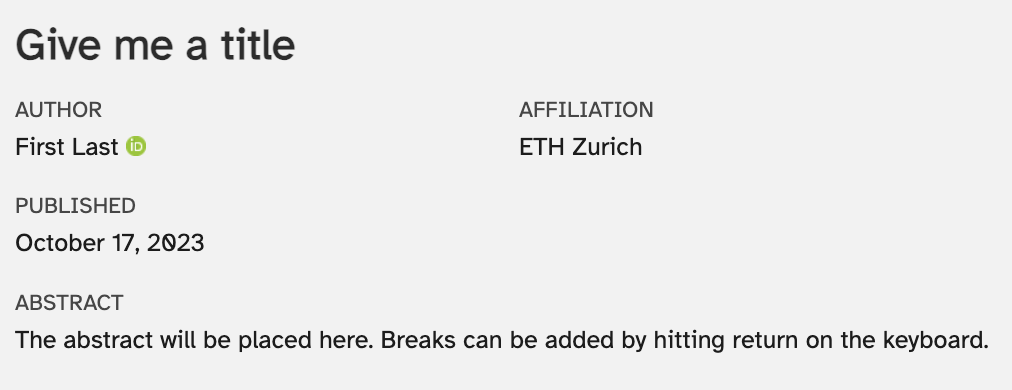
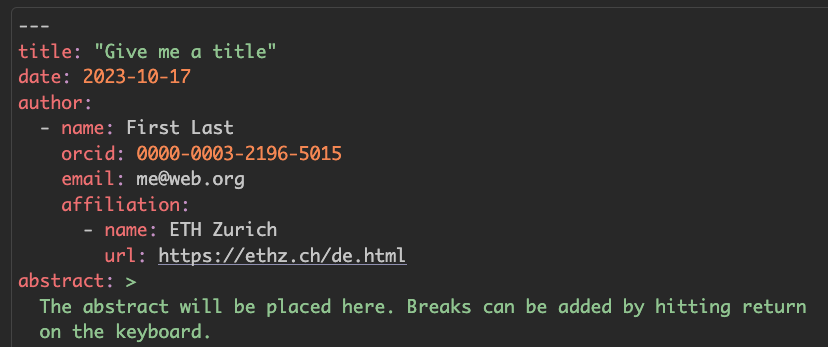
Our turn: md-07-exercises
- Open posit.cloud in your browser (use your bookmark).
- Open the rbtl-fs24 workspace for the course.
- Open md-07-exercises.
- In the File Manager in the bottom right window, locate the
scholarly-writing.qmdfile and click on it to open it in the top left window. - Follow along on the screen using the instructions in the document.
15:00
Publishing
Our turn: md-07-publish-USERNAME
Clone the repository from GitHub & publish using GitHub Pages.
- Open github.com in your browser and navigate to the GitHub organisation for the course: https://github.com/rbtl-fs24/.
- Find the repository md-07-publish-USERNAME that ends with your GitHub username, and open it.
- Click on the green “Code” button.
- Copy the HTTPS URL to your clipboard.
- Open the rbtl-fs24 workspace on posit.cloud
- Click New Project > New Project from Git Repository
- Paste the HTTPS URL from GitHub into the “URL of your Git Repository” field.
- Wait until the project is deployed.
- From the Files Manager in the bottom right window, open
docsfolder, then click onindex.qmd. - Indicate when you are ready.
05:00
GitHub Pages
- GitHub Pages is a free service for hosting static websites. It is ideal for blogs, course or project websites, books, presentations, and personal hobby sites.

Minimal Example - Requirements
- Landing site needs to be stored as
index.qmd - The
index.qmdneeds to be stored indocsfolder - Example works well for a report/article as a stand-alone page
- Quarto provides a framework and examples for more complex websites: https://quarto.org/docs/websites/
Course Guide
- Steps for publishing the capstone project report are described on the capstone project page
- https://rbtl-fs24.github.io/website/project
Take a break
Please get up and move! Let your emails rest in peace.
10:00
Image generated with DALL-E 3 by OpenAI
Capstone project
Submission
- The submission due date is: Tuesday, 06th June.
- A complete report receives 30 points.
- We will use the GitHub issue tracker to communicate and ask questions about the capstone project.
- A list of required items for submission is covered on the course website: https://rbtl-fs24.github.io/website/project/
Your turn: Capstone project - Read and take notes
- Open: https://rbtl-fs24.github.io/website/project/.
- Read through the page.
- For the list in “Required items” note down the numbers of those that are unclear to you and why.
- After the time is up, we will discuss unclear items in class.
10:00
Our turn: Capstone project - Discuss unclear items
- Share which unclear items you noted down.
10:00
Your turn: Capstone project - Share remaining unclear items on GitHub
- Open your Capstone project repository (
project-USERNAME) https://github.com/rbtl-fs24. - Add your questions for unclear items to the issue tracker.
05:00
Module 6 documentation
Homework due date
- Homework assignment due: Wednesday, April 17th
Next few weeks
- Lars will be off work until 30th May
- Elizabeth and Colin will support you during this time
| module | date | topic |
|---|---|---|
| 1 | 22 February 2024 | Welcome & get ready for the course |
| 2 | 29 February 2024 | Data science lifecycle & Exploratory data analysis using visualization |
| 3 | 07 March 2024 | Data transformation with dplyr |
| 4 | 14 March 2024 | Data import & Data organization in spreadsheets |
| 5 | 21 March 2024 | Conditions & Dates & Tables |
| 6 | 28 March 2024 | Data types & Vectors & Pivoting |
| NA | 04 April 2024 | Easter Break |
| 7 | 11 April 2024 | Joining tables & Creating and publishing scholarly articles with Quarto and GitHub pages |
| 8 | 18 April 2024 | Waste Research |
| 9 | 25 April 2024 | Research Design |
| 10 | 02 May 2024 | Survey Design |
| NA | 09 May 2024 | Auffahrt Break |
| 11 | 16 May 2024 | Pre-test and logistics |
| NA | 23 May 2024 | Data collection |
| 12 | 30 May 2024 | Data analysis & report writing |
| NA | 06 June 2024 | Project Submission Deadline |
| NA | 13 June 2024 | Exam |
Attribution
Content was re-used from a workshop hosted by Mine Çetinkaya-Rundel at the 2023 Symposium on Data Science and Statistics and stored at https://github.com/mine-cetinkaya-rundel/quarto-sdss. The original content is licensed under a Creative Commons Attribution 4.0 International License.
Thanks! 🌻
Slides created via revealjs and Quarto: https://quarto.org/docs/presentations/revealjs/ Access slides as PDF on GitHub
